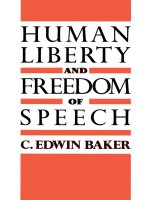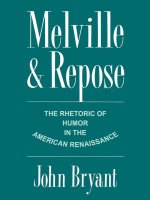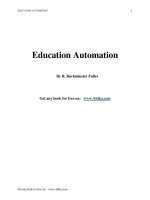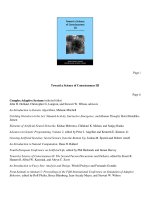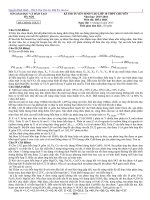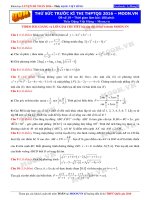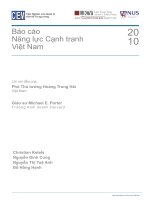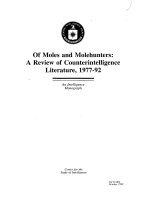Psat 2016 oct 19
Bạn đang xem bản rút gọn của tài liệu. Xem và tải ngay bản đầy đủ của tài liệu tại đây (4.6 MB, 61 trang )
Wednesday
'October 19, 2016
PSAT/NMSỢT"
Preliminary SAT/National Merit Scholarship Qualifying Test
IMPORTANT
REMINDERS
|
_A No. 2 pencil is required for the tẻst.
Do not use amechanical pencilor pen. _
Sharing any questions with anyone
ts. a violation of Test Security
1
and Fairness policies and may result
in your scores being canceled.
Preliminary SAT/National Merit Scholarship Qualifying Test
cosponsored by
/ mmạm
NATIONAL MERIT
© CollegeBoard / mua SCHOLARSHIP CORPORATION
5LPT02
THIS TEST BOOK MUST NOT BE TAKEN FROMTHE ROOM. UNAUTHORIZED.
REPRODUCTION OR USE OF ANY PART OF THIS TEST BOOK IS PROHIBITED.
ˆ (earnhg’
ogo ts federaly ered service mark of National
Mer Scholarship
of the College Board and National Merit Scholarship Corporation.
Corporation PSATINMSCN is related trademark
_.
{| | Hl
791694
Reading Test
60 MINUTES,
47 QUESTIONS
Turn to Section 1 of your answer sheet to answer the questions in this section.
DIRECTIONS
Each passage or pair of passages below is followed by a number of questions. After reading
each passage or pair, choose the best answer to each question based on what is stated or
implied in the passage or passages and in any accompanying graphics (such as a table or
'graph).
Questions 1-9 are based on the following passage.
This passage is adapted from Isabel Allende, Portrait in
Sepia. ©2001 by HarperCollins Publishers. The setting is
Chile during the late nineteenth century.
There was a general consensus in the family that I
was “going to come to a bad end.” By then the first
woman doctor had graduated in Chile, and others
Line had entered the university. That gave Nivea the idea
5 that I could do the same, if only to defy the family
and society in general, but it was obvious that
I didn’t
haye the least aptitude for studying. Then Severe del
Vaile appearé
fa and set it in my
lap
It was a beautiful Kodak, precious in the details of
10 every screw, elegant, smooth, perfect, made for the
hands of an artist. I still use it, it never fails. No girl
my age had a toy like that. I picked it up with
reverence and sat looking at it without any idea how
to use it.“Let’s see if you can photograph the dark
15 shadows in your nightmares,” Severo del Valle said
Don Juan Ribero, who was a half head shorter
2
than my grandmother and ‘half her weight, settled his
0 eyeglasses on his nose, carefully read the amount
written on the check, and then handed it back to her,
looking her up and down with infinite scorn.
5
“The amount isn’t a problem. You set the price,”
my grandmother wavered.
“It isn’t a question of price, but of talent, sefiora,”
he replied, guiding Paulina del Valle toward
the door.
During that exchange I’d had time to take a quick
look around. Ribero’s work covered the walls:.
40 hundreds of portraits of people of all ages.
~ Ribero was the favorite of the upper class, the
photographer of the social pages, but the people
gazing at me from the walls of his studio were not
bigwig conservatives or beautiful debutantes, but —
45 Indians, miners, fishermen, laundresses, poor
childrén;obd:
Y¥ women like the ones my
the best photographer in Santiago, a curt man as dry
grandmother helped with her loans. from the ladies
club. There I saw represented the multifaceted and
toritiented face of Chile. Those people in the
50 photographs touched something deep inside me;I
wanted to know the story of every one of them. I felt
"a pressure in my chest, like a closed fist, and an
uncontainable desire to cry, but I swallowed my
“T’ve brought you my granddaughter to be your
55 head high. In the carriage she tried to console me: I
shouldn’t worry, she said, we would get someone else
as a joke, never suspecting that that would be my
one objective for months, and that in the task of
deciphering that nightmare I would end up in love
with the world. My grandmother took me to the
20 Plaza de Armas, to the studio of Don Juan. Ribero,
as stale bread on the outside, but generous and
sentimental inside.
25 apprentice,” my grandmother said, laying
a check on
the artist’s desk while I clutched her skirttail with
one hand and my brand-new camera in the other.
Unauthorized copying or reuse of any part of this page is illegal.
emotion and followed my grandmother out with my
to teach me to operate the camera, photographers
were a dime a dozen; what did that second-rate
lowborn think, anyway, talking in that arrogant tone
Er
ˆ Test begins on the next page.
|
60 to her. Paulina del Valle! And she grumbled on and
on, but I Wasn't listening: I had decided that no one
but Juan Ribero would be my teacher. The next day I
left the-house before my grandmother was up. I told
the coachman to take me to the studio and
65 planted myself in the street, prepared to wait forever.
Don Juan Ribero showed up about eleven, found me
_at his door, and ordered me to go home. I was shy
then—I still am—and very proud; I wasn’t used to
The passage describes an important distinction
between
A)
B)
_
m—-
Paulina del Valle’s behavior toward her relatives
and her behavior toward those who are poor.
Paulina del Valle’s benevolence and Severo del
Valle’s benevolence.
C)
70 I was coddled like a queen, but my determination
must have been very strong. I didn’t move from the
Don Juan Ribero’s polite behavior and his
rebellious feelings.
D)
out, threw me a furious glance, and started walking
down the street. When he came back from his lunch,
75 he found me still there with my camera clutched to
my chest. “All right,” he muttered, defeated, “but I
Don Juan Ribero’s professional activities and his
preferred projects.
Which choice best supports the idea that Paulina del
asking for anything because from the time I was born
door. A couple of hours later, the photographer came
warn you, little girl, that I won’t give you any special
consideration. Here you come to obey without
talking back and to learn quickly, is that clear?” I
80 nodded silently because my voice was stuck in my
‘throat.
Aes
eee
Mu
BS
How did Paulina del Valle expect
to persuade
Don Juan Ribero to take on her granddaughter as an
apprentice?
"
A)
B)
C)
D)
By paying him generously
Byflattering him
By appealing to his sympathy
By supporting his socialambitions
Unauthorized copying or reuse of any part of this page is illegal.
Valle feels that she is entitled to special treatment?
A)
Lines 24-25 (“I’ve ... apprentice”)
B)
Lines 56-60 (“we would . .. del Valle”)
C)
Lines 60-61 (“And she. . . listening”)
D)
Lines 62-65 (“The next... forever”)
Be
ies
In the first paragraph, the narrator emphasizes the
A)
the benefits of a life of wealth and privilege and
the rewards of determination and hard work.
B)
her earnest attitude and Severo del Valle’s
playful tone.
:
the family’s overwhelming preoccupation with
materialism and her focus on art and beauty.
C)
D)
her attempts to assert her own independence and
the grandmother’s authoritarian control over the
' family.
Lines 28-37 (“Don .. . door”) primarily serve to
A)
B)
C)
D)
portray the grandmother’s response
rejection.
to a
reveal Don Juan Ribero’s personality through
his behavior.
point out Don Juan Ribero’s changeable nature.
emphasize the serious nature of a setback for
Don Juan Ribero.
Unauthorized copying or reuse of any part of this page is illegal.
As used in line 33, “set” most nearly means
A)
post.
B)
apply.
C)
determine.
D)
waive.
As used in line 38, “exchange” most nearly means
A)
trade.
B)
difference.
C)
conversation.
D)
barter.
.
Which statement about Don Juan Ribero helps
explain why he changes his mind about teaching
the girl?
Which choice provides the best evidence forthe
answer to the previous. question?
A)
A) He is desperate to continue working.
Lines 19-23 (“My ... inside”)
B)
Lines 41-48 (“Ribero .. . club”)
B)
He is not as unkind as he appears.
C)
Lines 72-74 (“A couple... street”)
C)
He realizes he has much to lose otherwise.
D)
Lines 78-79 (“Here ... clear”)
D) He recognizes the girl’s talent.
Unauthorized copying or reuse of any part of this page is illegal.
5
Questions 10-18 are based on the following
passage and supplementary material.
This passage is adapted from Peter W. Huber and
Mark P. Mills, The Bottomless Well. ©2005 by Peter W. Huber
and Mark P. Mills.
Though he was prepared to go quite a bit deeper
when he turned on his steam-powered drill in
Crawford County, Pennsylvania, in 1859,
Line Colonel Edwin Drake struck oil at 69,feet. The first
5 “deep water” oil wells stood in 100 feet of water in
1954. Today, they reach through 10,000 feet of water,
20,000 feet of vertical rock, and another 30,000 feet of
horizontal rock.
Yet over the long term, the price of oil has held
10 remarkably steady. Ten-mile oil costs less than
69-feet
Oil did; and about the same as one-mile oil
did two decades ago. Production
in the hostile
waters of the Statfjord oil field of the North Sea are
notvery
different from costs at the historic
15 Spindletop fields of southeast Texas a century ago.
There have been price spikes and sags, but they have
been tied to political and regulatory instabilities, not
`
discovery and extraction costs: This record is all the
ME
more remarkable when one considers that the
20 amount of oil extracted has risen year after year.
Cumulative production from U.S. wells alone has
surpassed a hundred billion barrels. The historical
trends defy all intuition.
.
It is easy enough to thank human ingenuity for
25 the relatively steady price
Of a fiitité and dwindling
resource and leave it at that. But fefểT8a second
part 6 this story: it is energy itself that begets more
| Nam
Electrically powered robots pursue new
supplies of oil at the bottom of the ocean. Electricity
)
⁄ *
\/
40 more logic paramount among them. For the first
two centuries of industrial history, the powered
technologies used to find and extract fuels improved
faster than the horizon of supply receded. Hence our
blue-whale! energy economy. End users consume
45 increasingly compact and intense forms of
har high-grade power, relying on suppliers to pursue and
.
capture increasingly distant, dispersed, and dilute
rì [ sources of raw fuel. The gap is foreyer widening, as
the history of oil extraction reveals, but that doesn’t
50 stop us—the more energy we consume, the more we
capture. It’s a chain reaction, and it spirals up, not
down. It is, if you will, a perpetual motion machine.
The machine is running faster today than ever
before, but it has been running for quite some time.
55 Four billion years ago, life on Earth captured no solar
energy at all, because there was no life. Life then got a
foothold, and the capture and consumption of energy
in the biosphere has been rising ever since. The
thicker life grew on the surface of the planet, the
60 more energy the biosphere managed to capture. And
it used all that energy to create more life.
Living green plants still capture today’s solar
energy about six times faster than we humans are
able to dig up yesterday’s solar energy preserved in
65 fossil fuels, but we'll overtake the rest of nature in
due course. Perhaps someday we'll get to the point
‘ where we, too, can capture our energy directly from
the sun. There’s plenty 6f sunlight to spare—green
plants currently capture only about one
70 three-thousandth of the golden cascade of solar
power that reaches the Earth’s surface.
But whether we catch our solar energy live, dig it
up in fossilized form, or mine uranium instead is
really just a detail. The one certainty is that we will
iop purifies and dopes the silicon that becomes the
) photovoltaic cell that generates more electricity.
| Lasers enrich uranium that generates more electricity
«that powers more lasers. Power pursues the energy
75 extract more energy from our environment, not less.
35
80 still more.
that produces the power.
“Energy
supply-
extracting
it. What isscarce is not raw energy but the
drive and the logic that is able to locate, purify, and
channel it to. our-own ends—the creation of still
Unauthorized copying or reuse of any part of this page is illegal.
Everything we think we know about “running out of
energy” isn’t just muddled and wrong; it’s-the.exact
opposite of the truth. The more energy we capture
—
.
,
and put to use, the more readily we will capture
1 A reference to the suggestion that a modern American uses
about as much energy as a blue ‘whale does
30+
2+
distance to
oil price
i
oil—4
/
_
/
i
/
In the passage, the authors claim that the amount of
energy available for h
Oil price (dollars/million BTU, constant 2000 $)
Maximum distance to oil (thousand feet)
40
Maximum Distance to Oil
versus Average Price
eis
chiefly
dependent
on the.
A)
desire of end users to conserve power wherever
possible.
B)
ability to discover and draw from more sources
_C)_
D)
of supply.
success of new uranium enrichment
technologies.
future collection of solar energy directly from
the sun.
m
Which choice provides the best.evidence
for the
answer to the previous-question?
Adapted from WTRG Economics; EIA, Annual Energy Review. ©2003
by ExxonMobil; J. Ray McDermott Inc.
A)
Lines 32-33 (“Lasers ... more lasers”)
B)
Lines 35-37 (“Energy ... it”)
C)
Lines 55-56 (“Four.. ... no life”)
D)
Lines 66-68 (“Perhaps ... sun”
According to the passage, the relationship between
energy
extraction and use by humans is best
characterized as
A)
Unauthorized copying or reuse of any part of this page is illegal.
`
B)
taxed by excessive demand.
self-propagating and propulsive.
C)
driven by political dissension.
D)
existing in competition with natural processes.
Which choice provides the best evidence for the
answer to the previous question?
The details in lines 28-33 (“Electrically. . . lasers”)
serve mainly to
A)
Lines 24-26 (“It is... that”)
B)
Lines 37-39 (“What... ends”)
A)
support a claim.
B)
complete a comparison.
C)
Lines 51-52 (“It’s a... machine”)
C)
sketch a narrative.
D)
Lines 62-65 (“Living . . . fuels”)
D) suggest a paradox.
4
ae
"
oe
As used in line 17, “tied to” most nearly means
A) united with.
B)
connected to.
C)
bound by.
D)
equivalent to.
|
Unauthorized copying. or reuse of any part of this page is illegal.
As used in line 46, “pursue” most nearly means
A)
seek.
B)
chase.
C)
engage in.
D)
proceed with.
-
In the passage, the “gap” (line 48) refers to the
According to the graph, the maximum 1distance to oil
A)
A)
1875-1900
B)
1925-1950
C)
1950-1975
D)
1975-2000
disparity between the increasing
B)
distance of energy sources from Earth’s surface
and the decreasing quality of high-grade power
obtainable from them.
concern over the environmental risks of
extraction and the decreasing attention to the
actual impact of current extraction methods.
C)
awareness of the history of extraction and the
decreasing concern about likely future
developments.
D) concentration of energy as it is used and the
decreasing concentration of supplies of
unextracted energy.
Unauthorized copying or reuse.of any part of this page is illegal.
first reached 25,000 feet during which span of years?
Questions 19-28 are based on the following
passage and supplementary material.
Remage-Healey found clear evidence of
antipredator responses when the toadfish heard pop
sounds. No differences were found in call rate
| between males before exposure to the experimental
sounds. (See graph.) Males exposed to pop sounds,
go however, reduced their call rates by 50 percent. In
addition, males exposed to the pop sounds
This passage is adapted from Lee Alan Dugatkin, Principles
of Animal Behavior. ©2009 by W. W. Norton & Company, Inc.
In systemis in which predators hone in on sounds
made by their prey, one of the simplest things that an
animal can do to avoid such predators is to be quiet.
(4 maintained their reduced calling rate for the
| five minutes following exposure to pops—that is,
| they eavesdropped on their predators and reduced
Line With this in mind, Luke Remage-Healey and his
5 colleagues examined the role of sound suppression
in the antipredator repertoire of the Gulf toadfish.
Gulf toadfish are a major food staple of adult
bottlenose dolphins, making up 13 percent ‘of the
dolphin’s diet. Prior work had shown that dolphins
10 orient toward the “boatwhistle” sound produced by
58 their activity in a way that made capture by a dolphin
: less likely. Males in the other treatments showed no
' changes in boatwhistle call rate when they heard the
recorded sounds.
Remage-Healey and his team followed up their
60 behavioral work on call rates and exposure to
predators with a hormonal analysis that examined
At whether dolphin pops produce a stress response in
male toadfish during breeding season. That is,
dolphins are eavesdropping on the sounds produced
by toadfish to better orient toward their prey. Once a
toadfish is located by eavésdiopping, the dolphin
% A
»
(15
locks
onto this prey and tracks it. Given this,
7S
2
the question Remage-Healey and his colleagues
addressed was whether the toadfish respond in kind,
the toadfish. After experimentally exposing the male
3
toadfish to pops or snapping shrimp sounds, the
65 researchers drew blood from the males, and they
measured their cortisol! levels. Males exposed to
listening for sounds associated with bottlenose
pops not only responded to the pops by reducing
foraging behavior, and then reducing the boatwhistle
their own boatwhistle call, but they also showed
higher levels of cortisol than males exposed to the
20 sounds they produce.
Bottlenose dolphins produce a variety of differenit
70 sound of snapping shrimp.
sounds, ranging from high-frequency whistles used
in dolphin-to-dolphin social communication (not
foraging), as well as two sounds that are particularly
1 A hormone produced in response to stress
25 associated with foraging— “clicks” and low-frequency
“pops.” The pops are easiest for toadfish to hear,
_ Since this species hears most accurately in the
low-frequency-range, and so Remage-Healey and his
team focused on these dolphin sounds.
30
The researchers captured toadfish during the
~® 160
5 140
Š2 120
:
>75 60TOYOY
breeding season, and they kept individual males in
tanks until the breeding season ended. The males
soon began to emit boatwhistle sounds, presumably
8
to attract females. At‘that point, toadfish males were
wr
Y
20-2
ce
35 exposed to one of three sounds—the pops associated
with dolphin foraging, the high-frequency whistles
produced during dolphin social communication,
and, as a control, the “snapping” sounds made by
snapping shrimp. All sounds were broadcast using
40 underwater speakers, and the activity of toadfish was
recorded for the five minutes before sounds were
¬
before
|.Đ.
,
z
:
playback
period
1
during
playback
period
An
after
playback
period
dolphin whistles and pops
[) dolphin pops alone
emitted, the five minutes during which the
@
experimental sounds were broadcast, and the
five minutes after the sounds were played.
Unauthorized copying or reuse of any part of this page is illegal.
Gulf Toadfish Responses to Various Sounds
dolphin whistles alone
snapping shrimp pops
10
ee) na
Le
.
The passage indicates that the researchers chose
The author mentions that toadfish are “ lạ, percent oof
the dolphin’s diet” (lines 8-9) most likely to
A)
eliminate an irrelevant factor from
B)
suggest that an ambitious project is unlikely
to succeed.
pops to broadcast primarily because _
dolphin
A) other dolphin foraging sounds are more difficult
for male toadfish to hear.
consideration.
C) explain a problem by way of analogy.
D) clarify the reasoning behind a choice.
| B)
dolphin pops would be audible over the toadfish
C)
dolphin pops bear a close resemblance to sounds
D)
boatwhistles.
made by snapping shrimp.
toadfish call rates would remain relatively
consistent in response to dolphin pops. „
As used in line 15, “tracks” most nearly means
A)
marks.
B)
follows.
C)
observes.
answer to the previous
us quuestion? ˆ
A) Lines 26-28 (“The pops. .. range”)
D)
carries.
B)
Lines 34-35 (“toadfish . . . three sounds”)
C)
Lines 51-53 (“males exposed . . . pops”)
D)
Lines 56-58 (“Males in . . recorded sounds”)
“Unauthorized copying or reuse of any part of this page is illegal.
Which choice provides the best evidence for the
11
The main purpose of the fifth
th paragraph
The passage mostst strongly suggests
s
that exposure to
(lines 45-58) is to
A)
summarize findings.
B)
evaluate a claim.
dolphin. pops.causes male toadfish to
C) revise an initial hypothesis.
D) explain unanticipated consequences.
As used in line 62, “produce” most nearly means
A)
A)
B)
reduce their foraging behavior.
emit only high-frequency sounds.
C)
shift their direction away from the pop sounds.
D)
undergo a hormonal stress response.
Which choice provides the best evidence for the
answer to the previous question?
spread.
B) compose.
A)
Lines 45-47 (“Remage-Healey . . sounds”)
C)
cause.
B)
Lines 49-50 (“Males . . . percent”)
D)
offer.
C) : Lines 59-63 (“Remage-Healey. . . toadfish”)
D)
Unauthorized copying or reuse of any part of this page is illegal.
12
Lines 66-70 (“Males exposed . . . shrimp”)
Ei
mg:
hier
In the graph, the fourbars showing the lowest _
call rates primarily support Remage- Healeys §
According tot thehe graph, which of the following had
the greatest effect on the call rates of Gulf ‘toadfish?
A)
B)
C)
D)
conclusion that
The length of the playback period
Snapping shrimp pop sounds
Dolphin pop sounds alone
Dolphin whistle sounds alone
A) bottlenose dolphins mimic boatwhistle sounds
to improve foraging,
B)
C)
male toadfish inhibit their boatwhistle sounds
for self-protection.
dolphin foraging behavior has a direct effect on
toadfish reproduction.
D) male toadfish vocalize less after playback than
they do during playback.
Unauthorized copying or reuse of any part of this page is illegal.
-
13
Questions 29-38 are based on the following
passage.
This passage is adapted from Gifford Pinchot, The Fight for
Conservation. Originally published in 1910. Pinchot
was a US politician and forest conservationist.
No man may rightly fail to take a great pride in
what has been accomplished by means of the
destruction of our natural resources so far as it has
Line gone. It is a paradoxical statement, perhaps, but
5 nevertheless true, because out of this attack on what
- nature has given we have won a kind of prosperity
and a kind of civilization and a kind of man that are
new in the world. For example, nothing like the
rapidity of the destruction of American forests has’
10 ever been known in forest history, and nothing like
the efficiency and vigor and inventiveness of the
American lumberman has ever been developed by
any attack on any forests elsewhere. Probably
the most effective tool that the human mind and
15 hand have ever made is the American axe. So the
American business man has grasped his
opportunities and used them and developed them
and invented about them, thought them into lines of
success, and thus has developed into a new business
20 man, with a vigor and effectiveness and a
cutting-edge that has never been equaled anywhere
else. We have gained out of the vast destruction of
our natural resources a degree of vigor and power
and efficiency of which every man of us ought to be
25 proud: .
Now that is done. We have accomplished these
big things. What is the next step? Shall we go on in
the same lines to the certain destructioofn the
prosperity which we have created, or shall we take
30 the obvious lesson of all human history, turn our
backs on the uncivilized point of view, and adopt
cài r toward our natural resources the average prudence
._ and average foresight and average care that we long
ago adopted as a rule of our daily life?
.35
The conservation movement is calling the
attention of the American people to the fact that they
are trustees. The fact seems to me so plain as to
require only a statement of it, to carry conviction.
Can we reasonably fail to recognize the obligation
_ 40 which rests upon us in this matter? And, if we do fail
to recognize it, can we reasonably expect even a fairly
good reputation at the hands of our descendants?
_ Business prudence and business common-sense
indicate as strongly as anything can the absolute
45 necessity of a change in point of view on the part of
Unauthorized copying or reuse of any part of this page is illegal.
the people of the United States regarding their
natural resources. The way
we have been handling
them is not good business. Purely on the side of
dollars and cents, it is not good business to kill the
50 goose that lays the golden egg, to burn up half our
forests, to waste our coal, and to remove from under
the feet of those who are coming after us the
opportunity for equal happiness with ourselves.
The thing we ought to leave to them is not merely an
55 opportunity for equal happiness and equal
prosperity, but for a vastly increased fund of both.
Conservation is not merely a question of business,
a * buta question of a vastly higher.duty. In dealing with
our natural resources we have comie to a place at last
60 where every consideration of patriotism, every
consideration of love of country, of gratitude for
things that the land and the institutions of this
Nation have given us, call upon us for a return. If we
owe anything to the United States, if this country has
65 been good to us, if it has given us our prosperity, our
education, and our chance of happiness, then there is
a duty resting upon us. That duty is to see, so far as in
us lies, that those who are coming after us shall have
the same opportunity for happiness we have had
70 ourselves. Apart from any business consideration,
apart from the question of the immediate dollar, this
problem of the future wealth and happiness and
prosperity of the people of the United States has a
right to our attention.
The author characterizes environmental
The author’s central claim in“che pascageis that
A)
B)
C)
D)
conservation primarilyas. a
future generations’ success matters more than
A) responsible form of civic engagement.
B) practical means of increasing economic
the continued prosperity of today’s generation.
businesses are learning to regulate their
productivity.
environmental impact.
belated attempt to address an ongoing crisis.
conservation is necessary to ensure a prosperous
future.
controversial approach to a sensitive issue.
America had to use natural resources at an
elevated rate to gain its current wealth.
The questions in lines 27:42
2 12 (“What
Over the course of the passage, the main focus
shiftsfrom
eT es
A) “condemnation of the destruction that has taken
place in the name of progress to discussion of the
role of business in that destruction.
B)
acknowledgment of the benefits America has
enjoyed by depleting natural resources to a call
to use those resources more wisely.
C)
analysis of the damage done to America’s forests
D)
appealing to people’s sense of duty to conserve
C)
resources to examining the dangers of failing to
conserve.
:
underscore the necessity of the approach the
author advocates.
D) encourage the reader to weigh different options.
to proposal of a practice to reverse that damage.
Unauthorized copying or reuse of any part of this page is illegal.
bas
descendants”) mainly serve to
A) illustrate the author’s feelings of uncertainty.
B) suggest the complexity of the choices to be made.
15
we
Repetition of the word “average” in lines 32-33
emphasizes the author’s point by suggesting that
would not be extraordinary.
_ C)
A)
Lines 15-22 (“So the... else”)
B)
Lines 47-48 (“The way ... business”)
C)
Lines 48-53 (“Purely . . ourselves”)
D)
Lines 54-56 (“The thing ... both”)
.
unpopular policies should be clarified for the
general public.
oer
W
D)
all eras have similar experiences of initially
controversial reforms.
new strategies would rapidly become standard
practice.
One financial justification that the author offers for
greater conservation is that businesses will
A) ‘be able to operate more cost-effectively.
B)
become more adept at problem solving.
C)
D)
avoid costly environmental regulations.
have continued availability-of natural resources.
Unauthorized copying or reuse of any part of this page is illegal.
Oe
answer to the previous question?
A) the efforts needed to bring about desired changes
B)
une!
Which choice provides the best evidence for the
ui
THẬP
sss
As used in line 58, “duty” most nearly means
A) responsibility.
B)
assignment.
C)
tax.
D)
promise.
Which choice provides the best evidence for the
answer to the previous question?
Based on the passage, the author would most likely
agree with which of the following statements?
A)
B)
Government policies can be more effectively
framed and implemented if public opinion is
consulted only sparingly.
Future generations have a right to enjoy the
same advantages that previous generations have
enjoyed.
C)
A)
Lines 27-34 (“Shall . . . life”)
B)
Lines 57-58 (“Conservation . . . duty”)
C)
Lines 58-63 (“In dealing... return”)
D)
Lines 67-74 (“That .. . attention”)
_
Political leaders should prioritize citizens’
happiness over the enduring health of the
economy.
D) Voluntary actions on the part of businesses
achieve conservation more effectively than
government regulation does.
Unauthorized copying or reuse of any part of this page is illegal.
17
exe
Questions 39-47 are based on the following
passages.
Passage 1 is adapted from Edwin Hubble, The Realm of the
Nebulae. ©1982 by Yale University Press. Originally
published in 1936. Passage 2 is adapted from Gary Taubes,
“Beyond the Soapsuds Universe.” ©1997 by Kalmbach
Publishing Co. Throughout Passage 1, Hubble refers to
galaxies as “stellar systems” and our galaxy, the Milky Way,
as “the stellar system.”
Passage 1
The sun is a star among the many millions which
form the stellar system. The stellar system is a swarm
of stars isolated in space. It drifts through the
Line universe as a swarm of bees drifts through the
5 summer air. From our position somewhere within
the system, we look out through the swarm of stars,
past the borders, into the universe beyond.
The universe is empty, for the most part, but here
and there, separated by immense intervals, we find
10 other stellar systems, comparable with our own. They
are so remote that, except in the nearest systems, we
do not see the individual stars of which they are
composed. These huge stellar systems appear as dim
patches of light. Long ago they were named
15 “nebulae” or “clouds”—mysterious bodies whose
nature was a favorite subject for speculation.
But now, thanks to great telescopes, we know
something of their nature, something of their real
size and. brightness, and their mere appearance
20 indicates the general order of their distances. They
ys
Margaret Geller first met the stickman in the fall
of 1986. While the exact date has faded from her
recollection, she remembers the time as
midafternoon and her reaction as a kind of euphoria.
45 No one had ever seen the stickman before—at least,
not really. Valérie de Lapparent noticed it but says
she was too inexperienced to understand its
implication. John Huchra says he took one look at
the stickman and assumed he had botched his
50 observations. It took Geller’s eye'to recognize the
stickman as something réal and important.
Geller, Huchra, and de Lapparent had mapped the
nearby universe, taking several months to carefully
measure the distance to 1,000 galaxies, some as near
55 as 30 million light-years away, others as far as
650 million. De Lapparent had fed the distance and
positions of those galaxies into a computer program
that printed out a two-dimensional representation of
their three-dimensional distribution in the universe.
60 On the printout was this slice of the northern sky,
sprinkled with 1,000 distant galaxies, and smack in
the middle, says Geller, was this remarkable stickman
figure. The distribution of galaxies looked like a
. child’s drawing of a somewhat bowlegged person. It’s
„ 65 a whimsical name for a grand figure: the stickman
extended 500 million light-years across the universe.
Its torso was composed of hundreds of galaxies, a
massive congregation known to astronomers as the
Coma cluster. Its arms were two more sheets of
are scattered through space as far as telescopes can
penetrate. We see a few that appear large and bright.
70 galaxiés streaming across the night sky.
space, farther and ever farther, until, with the faintest
nebulae that can be detected with the greatest
telescope, we arrive at the frontiers of the ‘known
75 homogeneous place. Astronomers believed that
These are the nearer nebulae. Then we find them
smaller and fainter, in constantly increasing
25 numbers, and we know that we are reaching out into
30
Passage 2
universe.
This last horizon defines the observable region of
space. It is a vast sphere, perhaps a thousand million
light-years in diameter. Throughout the sphere are
scattered a hundred million nebulae—stellar
systems—in various stages of their evolutionary
35 history. The nebulae are distributed singly, in groups,
_ and occasionally in great clusters, but when large
volumes of space are compared, the tendency to
cluster averages out. To the very limits of the
© telescope, the large-scale distribution of nebulae is
40 approximately.uniform. ˆ
Unauthorized copying or reuse of any part of this page is illegal.
The stickman was grand not just in dimension but
in destiny. You might even say it changed our
understanding of the universe. Until the stickman,
the universe appeared to be a smooth and
galaxies were distributed at random, although they
might occasionally form clusters like Coma
containing as many as a thousand or so galaxies like
the Milky Way. There was even some evidence that
80 the universe contained at least one enormous void, in
the constellation Bodtes, which seemed to extend for
some 200 million light-years—and other suggestions
that galaxies could be found strung out on long
filaments. But in 1985 most astronomers. assumed
a5 these structures were products not of the universe
itself but of the methods used to survey ít
-CONTINUE”
Then Geller saw the stickman, which constituted
compelling evidence that galaxies were congregating
on two-dimensional structures, as though they had
90 condensed out of the cosmic nothingness on the
surfaces of invisible bubbles.
In Passage 2, the author characterizes Geller as="
someone
A) “questioned her oown n ability to make accurate
observations.
B)
C)
because the Sun is located
A) within a system containing millions of stars.
B)
in the space between stellar systems.
C)
on the edge of a vast system of nebulae.
D)
at the frontiers of the observable universe.
gryrcirtnerssn
cac
who
D)
knew her research had uncovered something of
significance.
had long believed an existing scientific model
was flawed.
lacked the experience needed to recognize a
pattern in her data.
As used in line 65, “grand” most nearly means
mm
A)
As used in line 39, “distribution” most nearly means
A)
movement.
B)
probability.
C)
spread.
D)
extension.
luxurious.
B) tasteful.
C) gallant.
D) imposing.
,
ˆ
Passage 2 most strongly suggests hat
that prior to the
discovery of the stickman, most astronomers”
peers
believed that galaxies
A) were scattered haphazardly throughout space.
B) existed mostly along two-dimensional structures.
C) were usually found in enormous clusters.
D) were separated by numerous, vast regions of
empty space.
Unauthorized copying or reuse of any part of this page is illegal.
1 9
SMUT
Which choice provides the best evidence for the
A)
Lines 52-53 (“Geller . .. universe”)
In which lines does the author of Passage an most
directly acknowledge the view of nebula arrangement
asserted by the author of Passage 1?
B)
Lines 60-63 (“On the... figure”)
A)
C)
Lines 75-79 (“Astronomers ... Milky Way”)
B)
D)
Lines 87-91 (“Then. .. bubbles”)
answer to the previous question?
Lines 52-56 (“Geller ... 650 million”)
Lines 63-64 (“The distribution . .. person”)
C)
Lines 73-75 (“Until . .. place”)
D)
Lines 84-86 (“But in... it”)
Which choice best states the relationship between the
' two passages?
.
A)
Passage 2 supports a controversial point of view
stated in Passage 1.
B)
Passage 2 suggests practical benefits of a
~ breakthrough described in Passage 1.
C) Passage 2 describes a discovery that was not
anticipated in Passage 1.
D)
Passage 2 proposes an experiment
Based on the passages, it can reasonably be
concluded that before 1985, the universe was
thought to
A) consist of nearby galaxies.
B) lack large-scale structure.
C) extend a short distance past the Milky Way.
that could
confirm a hypothesis offered in Passage 1.
D) havea limit beyond which no galaxies existed.
STOP
If you finish before time is called, you may check your work on this section only.
Do not turn to any other section.
Unauthorized copying or reuse of any part of this page’is illegal.
_ No Test Material On This Page ©
Writing and Language Test
35 MINUTES, 44 QUESTIONS
Turn to Section 2 of your answer sheet to answer the questions in this section.
DIRECTIONS
Each passage below is accompanied by a number of questions. For some questions, you
will consider how the passage might be revised to improve the expression of ideas. For
other questions, you will consider how the passage might be edited to correct errors in
sentence structure, usage, or punctuation. A passage or a question may be accompanied by
one or more graphics (such as a table or graph) that you will consider as you make revising
and editing decisions.
Some questions will direct you to an underlined portion of a passage. Other questions will
direct you to a location in a passage or ask you to think about the passage as a whole.
After reading each passage, choose the answer to each question that most effectively
improves the quality of writing in the passage or that makes the passage conform to the
conventions of standard written English. Many questions include a “NO CHANGE” option.
Choose that option if you think the best choice is to leave the relevant portion of the
passage as it is.
Questions 1-11 are based on the following passage.
im
Portraits by Cameron
'
.
A woman emerges from a dark background, half in
shadow. She wears a curious expression that, while it
A)
NO CHANGE
B)
while
C)
although
D)
since
doesn’t register happiness, doesn’t entertain sadness
either. She regards the viewer frankly, much as a viewer
might regard her. This photograph, displayed at the
Metropolitan Museum of Art in New York City, was
taken in 1867, [Ij so it feels immediate, as if its subject
were staring back at the viewer in the present moment. It
Unauthorized copying or reuse of any part of this page is illegal.
22
E>
is the work of photographer Julia Margaret Cameron,
who is sometimes thought ofasa painter who used a.
camera as her canvas,
At this point, the writer is considering adding the
following sentence.
Although Cameron was born in India, for much
of her adult life she lived and worked in the Isle
of Wight village of Freshwater, which was then
and still remains a popular seaside tourist
Cameron began taking pictures at the advent of
photography. Whereas Victorian society was fascinated
by the camera’s ability to document detail without
ornament, Cameron El encompassed artifice, carefully
choosing her subjects and controlling each sitting to
express her own unconventional, sometimes whimsical,
destination.
Should the writer make this addition here?
A)
Yes, because it helps explain why Cameron’s
B)
Yes, because it foreshadows the discussion of
Cameron setting up allegorical tableaux.
C)
No, because it doesn’t mention that her studio
sense of the world. She socialized with the luminaries of
her time: painters, writers, and (RM scientists. Many of
whom sat for her camera in her Isle of Wight studio,
studio attracted many well-known people.
was on the Isle of Wight.
D)
No, because it introduces a loosely related fact
A)
NO CHANGE
B)
enveloped
C)
embraced
D)
embellished
A)
NO
B)
scientists, many
C)
scientists, but many
D)
scientists: many
where she created some of the era’s most iconic portraits.
about Cameron, not about her photography.
In addition to portraits, Cameron produced a series of
highly theatrical, stylized, sepia-toned photographs’
known as tableaux, which often starred members of her
family as allegorical figures meant to depict a character
trait or an emotion.
A)
_B)
C)
D)_
Unauthorized copying or reuse of any part of this page is illegal.
CHANGE
NO CHANGE
highly theatrical, stylized, sepia- -toned,
photographs,
highly, theatrical, stylized sepia-toned
photographs
highly theatrical, stylized sepia-toned,
photographs
E>
Cameron was somewhat famous. Ofan 1864
exhibit, Photographic Journal wrote, “In these pictures all
Which sentence best introduces this paragraph?
that is good in photography has been neglected, and the
A)
NO CHANGE
B)
Cameron developed an interesting signature
style her family didn’t like.
C)
In her own time, Cameron’s photographs were
shortcomings of the art are prominently exhibited.” This
may seem like potent criticism, but Cameron herself
might well have approved
For instance, she
roundly criticized.
D)
endeavored to highlight her medium’s limitations and to
Cameras in Cameron’s time produced very
different images from those produced by today’s
digital cameras.
She manipulated light so that
it might fall on only half a face. Her manipulation of light
revealed the shadows beneath the eyes. She used a
chemical process to develop her film that resulted in
A)
NO CHANGE
B)
Besides,
)
D)
In fact,
Therefore,
Which choice most effectively combines the
underlined sentences?
A)
Her way of manipulating light was that it might
fall on only half a face; this would reveal the
shadows beneath the eyes.
B)
She manipulated light in such a way that this
manipulation might cause the light to fall on
only half a face; that would reveal the shadows
beneath the eyes.
C)
Manipulating light so that it might fall on only
half a face, she was revealing the shadows
beneath the eyes.
D) “She manipulated light so that it might fall on
only half a face, revealing the shadows beneath
the eyes.
Unauthorized copying or reuse of any part of this page is illegal.
24
Koni

